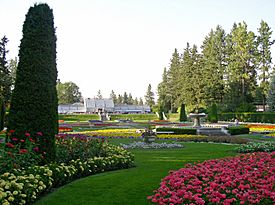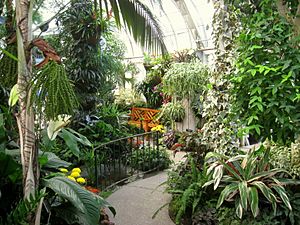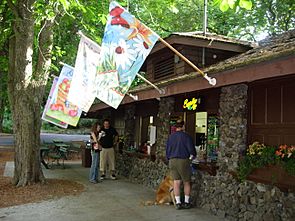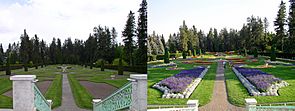Manito Park and Botanical Gardens facts for kids
Quick facts for kids Manito Park and Botanical Gardens |
|
|---|---|

Manito Park's Duncan Garden
|
|
| Type | Urban park |
| Location | Spokane, Washington |
| Area | 90 acres (360,000 m2) |
| Created | April 1904 |
| Operated by | Spokane Parks and Recreation Department |
| Status | Open year round (daily 5 a.m. to 11 p.m.) |
| Public transit access | Spokane Transit Authority |
| Website | https://my.spokanecity.org/parks/major/manito/ |
Manito Park and Botanical Gardens is a huge, 90-acre (0.36 km2) public park located in Spokane, Washington. It's a fantastic place with beautiful gardens, a special collection of trees called an arboretum, and a large greenhouse. The park is open every day and you can visit for free!
Contents
History of Manito Park
Manito Park wasn't always called Manito. It first opened as a public recreation area named Montrose Park. In 1903, its name was changed to Manito. This name comes from the Algonquian word manitou, which means "spirit" or "mystery."
In 1907, a special group was created to manage the park. Later, in 1913, famous landscape designers called the Olmsted Brothers helped plan how the park should look. They designed many parks, and Manito Park was one of them.
Did you know Manito Park used to have a zoo? It was open until 1932. The zoo closed because there wasn't enough money to keep it running during the Great Depression. This was a time when many people in the country faced financial hardship. Even today, you might spot an old iron bar sticking out of a rock. This was once part of the bear cages!
Exploring the Park
Beyond its amazing gardens, Manito Park offers many fun things to do. There are two play areas for kids. One is in the "upper Manito" section, and the other is near the duck pond.
The duck pond is in the northwest part of the park. It's a popular spot where you can see many ducks and geese swimming around.
If you get hungry, you can visit the Park Bench Cafe. This small cafe serves drinks and snacks during the summer months.
Some parts of Manito Park are left in their natural state. You'll see large basalt rocks and cliffs, especially in these undeveloped areas. These rocks are from ancient lava flows.
When winter arrives, the grassy hills in "lower Manito" become a favorite place for sledding. It's a great spot for some snowy fun!
Manito Park's Beautiful Gardens
Manito Park is famous for its stunning themed gardens. Each one offers a unique experience:
- Duncan Garden - This is a large, formal European-style garden. It covers about 3 acres and features a big granite fountain. The garden was designed and built in 1913. Its flower beds and plants are arranged in a perfectly symmetrical way.
- Joel E. Ferris Perennial Garden - This garden is filled with perennial plants. These are plants that live for more than two years, coming back year after year.
- Gaiser Conservatory - This is a large greenhouse located next to the Duncan Garden. It has two main sections. One section is home to desert plants, while the other is filled with tropical plants. It's like stepping into a different climate!
- Nishinomiya Tsutakawa Japanese Garden - This peaceful garden honors Nishinomiya, Japan. Nishinomiya is Spokane's sister city. The garden was designed by famous landscape architects and dedicated in 1974. It's a calm and beautiful space.
- Rose Hill - Here, you'll find about 1,500 rose bushes! They represent over 150 different types of roses. It's also a special test garden for new rose varieties.
- Dahlia Garden - This garden is next to Rose Hill. It's one of only eight official trial gardens for the American Dahlia Society. You can see many different kinds of dahlias here.
- Lilac Garden - Spokane is known as the "Lilac City." This garden shows why! It has over 100 different types of lilac plants.
Fun Activities at the Park
Manito Park is a great place for many activities. Visitors often enjoy:
- Playing baseball
- Going sledding in the winter
- Playing tennis
- And even bird watching
Some people also enjoy more unique activities like frolf (which is like golf but with frisbees) and parkour (a sport where you move through obstacles).
Images for kids
See also
 In Spanish: Parque Manito y jardín botánico para niños
In Spanish: Parque Manito y jardín botánico para niños




